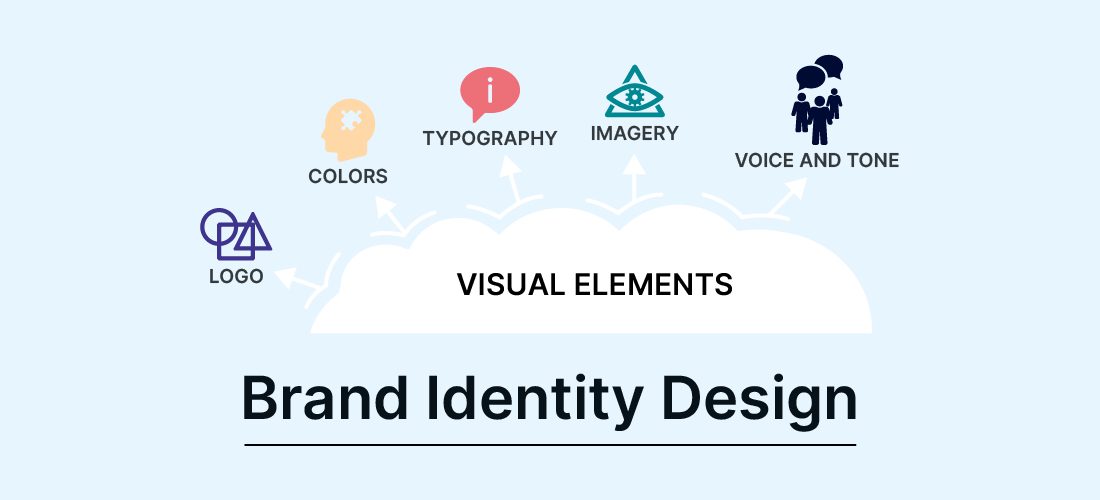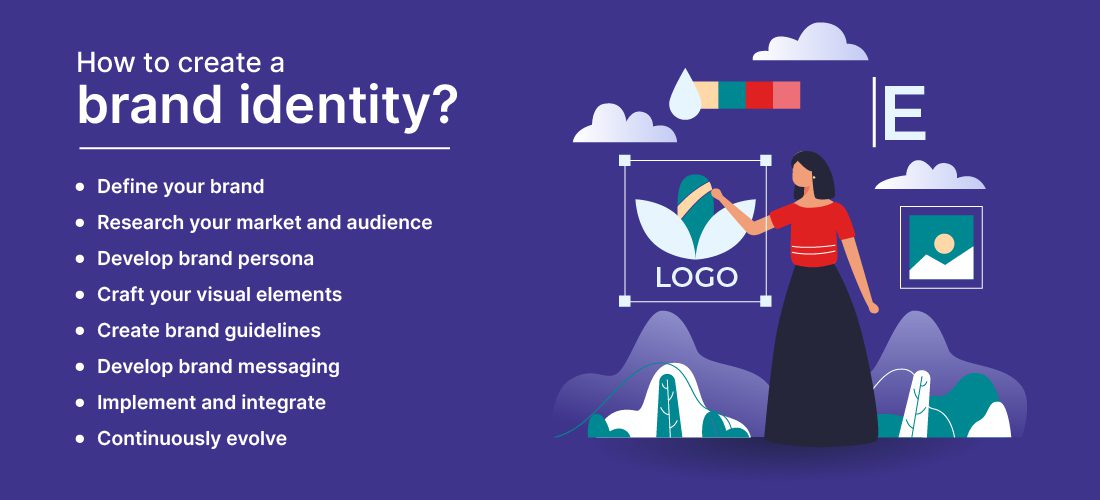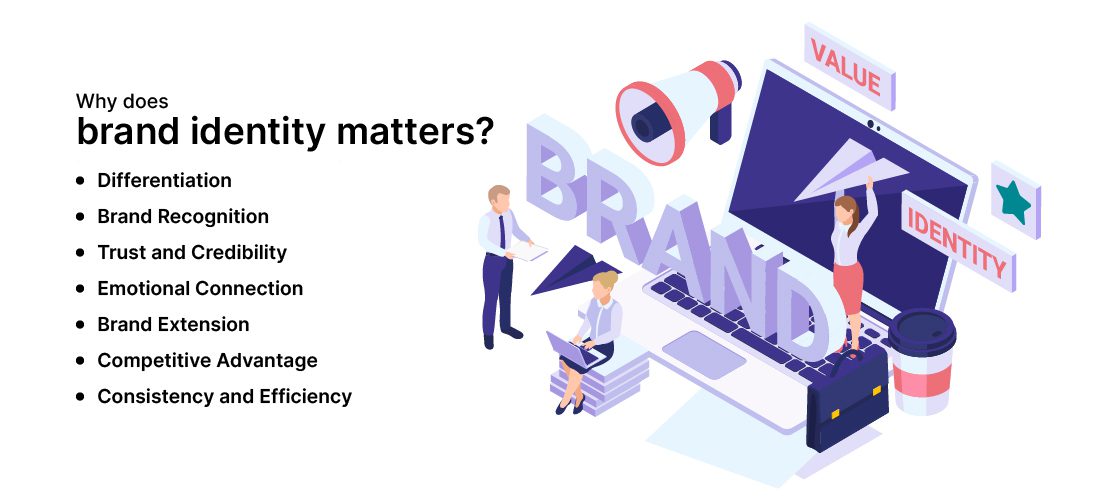
Sep 7, 2023

A strong brand identity is crucial in today’s competitive business world. It makes your brand unique and helps people remember and trust it. It includes things like your logo, colors, and style. It is the outward expression of your brand’s personality, values, and mission. It is how your brand presents itself to the world and the impression it leaves on consumers. When you see famous logos like McDonald’s golden arches or Nike’s swoosh, you immediately recognize their brands. But it is more than just visuals—it’s also about how your brand talks and connects with people. It’s like giving your brand a personality. This article explores what it is, why it matters, and how to create a powerful one for your brand. Whether starting a business or already have one, a strong identity will make your brand shine and stand out.

Brand identity is like the personality of your brand. It’s what makes your brand memorable and different from others. Think of it as how your brand looks, feels, and talks. It includes your logo, colours, typography, and even the tone of your brand’s voice.
Imagine your brand as a person. What would they look like? How would they dress? How would they speak? It is all about answering these questions and creating a consistent image for your brand. People can easily recognize and remember your brand when you make a strong brand identity. It enhances your trust and connection with your audience. It sets the stage for how people perceive and interact with your brand.
Working on it carefully, you can create a unique and memorable brand that stands out in the market. It’s an essential element for building a brand identity for successful and long-lasting brand. It makes a cohesive and consistent brand experience across all touchpoints, whether it’s your website, social media profiles, packaging, or advertising campaigns. It helps consumers recognize and remember your brand, differentiate it from competitors, and develop an emotional connection.

The concept of brand identity has evolved. Initially, it was primarily focused on logos and visual elements. However, with the rise of digital marketing and social media, it has become more dynamic and interactive. It now includes brand voice, storytelling, and customer engagement.

The origins of branding can be traced back to ancient times when artisans would mark their products with unique symbols or signatures. These marks served as a form of identification and quality assurance. Over the years, branding evolved from simple patterns to more sophisticated logos and visual identities.
During the Industrial Revolution, which took place from the 18th to the 19th century, branding underwent a significant transformation. With the advent of mass production and increased competition, companies recognized the need to establish distinct product identities. Logos and trademarks became more prevalent as recognizable symbols associated with specific brands. The rise of advertising and consumerism further fueled the importance of brand identity. Companies began to develop unique visual elements, such as logos, packaging, and slogans, to create a consistent and memorable brand image. As marketing strategies evolved, they became a crucial aspect of business success, allowing companies to establish trust, differentiate themselves from competitors, and connect with consumers on an emotional level. In the modern era, it has continued to evolve with advancements in technology and changes in consumer behaviour, playing a central role in shaping the success and perception of a brand.
One of the pioneers of modern branding is Paul Rand, who created iconic logos for companies like IBM, ABC, and UPS.

It is the process of creating the visual elements that represent your brand. It involves strategic decision-making and creative execution to ensure the design elements align with your brand’s values and resonate with your target audience. Here are the key components listed below:
Your logo is the centrepiece of your brand. It’s a visual symbol that represents your brand and creates instant recognition. A well-designed logo should be simple, memorable, and reflective of your brand’s personality. Think of iconic logos like Nike’s swoosh or Apple’s bitten apple.
Colours are crucial in brand identity design as they evoke emotions and convey meaning. Choosing the right colour palette for your brand is essential. Each colour should align with your brand’s values and produce the desired feelings in your audience. For example, blue represents trust and professionalism, while red represents energy and passion.
The fonts you use in your brand contribute to its visual appeal and consistency. Selecting appropriate typography helps establish your brand’s tone and personality. Whether classic serif or modern sans-serif, typography creates visual harmony and reinforces brand recognition.
Visual elements such as photographs, illustrations, and graphics contribute to brand identity. Consistency in imagery across all brand touchpoints helps create a distinct visual style. The choice of imagery should align with your brand’s values, target audience, and the emotions you want to evoke.
Your brand’s voice and tone are reflected in how you communicate with your audience. It should be consistent across all channels, whether your website, social media posts, or advertisements. Your brand’s voice can be friendly, professional, playful, or authoritative, depending on your brand’s personality and target audience.
When designing your brand identity, it’s essential to consider the overall cohesion and consistency of all these elements. They should work together harmoniously to create a unified and memorable brand image. Adapting your design to different mediums and platforms is crucial, ensuring that your brand maintains a consistent visual identity across all customer touchpoints.
By investing in thoughtful design, you create a visual identity that reflects your brand’s values, appeals to your target audience, and differentiates your brand from competitors. A well-executed brand builds recognition, trust, and loyalty, contributing to the overall success of your brand.
Also Read – Top Branding Trends of 2023

Creating a brand identity involves a strategic and thoughtful approach. It requires a deep understanding of your brand, target audience, and the market you operate in. Here are the key steps:
Start by clearly defining your brand’s mission, values, and unique selling proposition (USP). Understand what sets your brand apart and what you want to be known for. This is the foundational step to defining a strong brand.
Conduct market research to gain insights into your target audience’s preferences, needs, and desires. Understand their demographics, psychographics, and behaviours. This research will inform your brand identity design choices to connect with your audience effectively.
Imagine your brand as a person with distinct characteristics and traits. Define your brand’s personality, voice, and tone. Is your brand playful, authoritative, or friendly? These attributes will guide your brand’s communication style and overall identity.
Work with a professional graphic designer or branding agency to create visual elements. Start with a logo that captures your brand’s essence and resonates with your target audience. Choose colours, typography, and imagery that align with your brand persona and evoke the desired emotions.
Establish brand guidelines to ensure consistency in your brand identity. Document the specifications for logo usage, colour palettes, typography, and imagery styles. This will help maintain a cohesive and recognizable brand across different platforms and mediums.
Craft compelling, consistent messaging that reflects your brand’s values, positioning, and USP. Define key messages, taglines, and a unique brand story that resonates with your audience. Your brand’s messaging should be reflected in all communication channels.
Implement and integrate across all customer touchpoints consistently. Apply your visual elements and messaging to your website, social media profiles, packaging, marketing materials, and other brand-related materials. This integration helps reinforce your brand’s identity and creates a cohesive brand experience.
Keep an eye on market trends and consumer feedback. Be open to refining and adapting your brand identity as your brand grows and evolves. Regularly evaluate how your brand is perceived and make adjustments to ensure it remains relevant and resonates with your target audience.
It is an iterative process that requires patience and attention to detail. By following these steps and staying true to your brand’s values, you can create a compelling and authentic brand that connects with your audience and sets your brand apart from the competition.

Branding is not just about aesthetics; it is a strategic asset that can significantly impact your business. Let’s explore why it matters and the benefits it brings:
It is a strategic asset that goes beyond aesthetics. It differentiates your brand, fosters recognition, builds trust, establishes emotional connections, enables brand extension, provides a competitive advantage, and enhances consistency and efficiency. Investing in a strong brand design company helps your business thrive in a competitive marketplace and cultivates long-term relationships with your audience.
In conclusion, brand identity is a powerful asset for any business. It sets your brand apart, fosters recognition, and builds trust with your audience. It creates an emotional connection, provides a competitive advantage, and ensures consistency across all touchpoints. Investing in a good branding company is a worthwhile endeavor that can lead to customer loyalty and business success. By defining your brand’s personality, visual elements, and messaging, you can create a unique and memorable brand that resonates with your target audience. So, prioritize investing in a strong brand design company to make a lasting impression in today’s competitive marketplace.
To create a compelling brand identity on Instagram, define your brand’s unique value proposition and target audience. Develop a cohesive visual aesthetic that aligns with your brand’s personality, using consistent colors, fonts, and imagery. Craft a captivating bio that communicates your brand’s essence and values concisely. Create engaging content that reflects your brand’s story, values, and expertise, focusing on high-quality visuals and compelling captions. Leverage Instagram’s features, such as Stories, Reels, and IGTV, to showcase your brand’s authenticity and connect with your audience. Engage with your followers by responding to comments, using relevant hashtags, and collaborating with influencers or partners. Lastly, analyze your Instagram insights to measure the impact of your brand identity and make data-driven adjustments. Remember, building a solid brand identity takes time and consistency.
Visual brand identity refers to the tangible and visual elements representing a brand’s identity and creating a recognizable and consistent brand image. It encompasses various visual elements, such as logos, typography, colors, imagery, and graphic elements, used consistently across all brand communications. Visual brand identity is crucial in establishing brand recognition, differentiation, and emotional connection with the target audience. It helps convey the brand’s personality, values, and positioning in a visually cohesive and memorable way. By utilizing consistent visual elements, a brand can create a strong and distinctive visual identity that resonates with its audience and leaves a lasting impression.
The process of developing a brand identity typically involves the following five steps:
These steps help develop a solid and cohesive brand identity that effectively communicates your brand’s values and differentiates it from competitors.
The elements of a brand identity typically include:
By strategically defining and implementing these elements, a brand can create a cohesive and recognizable brand identity that effectively communicates its values, differentiates it from competitors, and resonates with its target audience.